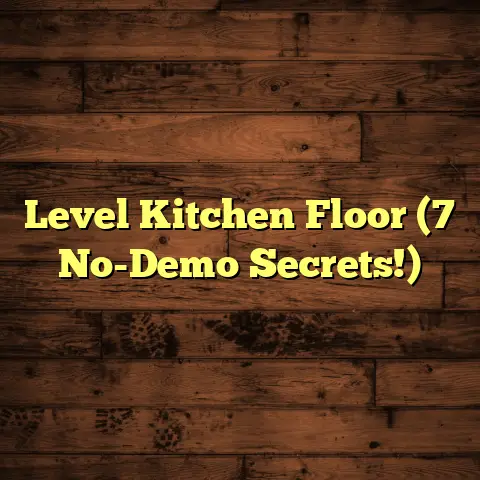Mold On Engineered Wood Floors: What To Do?
It’s where you unwind, pursue your hobbies, and create memories.
Maybe you’re into woodworking, crafting, or even just tinkering around the house.
I get it! I love creating things, too, and a good floor is the foundation for all of it.
Engineered wood floors are a popular choice, and for good reason. They look great and offer a good balance of style and practicality.
But what happens when something goes wrong? Like, really wrong? I’m talking about mold.
It’s a homeowner’s nightmare, and it can definitely put a damper on your hobbies and chill time. So, let’s dive into what you need to know about mold and your engineered wood floors. Let’s keep your space safe and beautiful.
Understanding Engineered Wood Floors
So, what exactly are engineered wood floors? I get this question a lot.
They’re not solid hardwood, and they’re not laminate.
Think of them as a multi-layered sandwich.
The top layer is a veneer of real hardwood, giving you that authentic wood look and feel.
Underneath, there are multiple layers of plywood or high-density fiberboard (HDF).
These layers are bonded together, creating a stable core that’s less susceptible to warping and moisture damage than solid wood.
Why is this important? Well, solid hardwood expands and contracts a lot with changes in humidity. Engineered wood is more stable.
Laminate, on the other hand, is a photographic image of wood glued to a composite core. It doesn’t have that real wood feel.
Engineered wood offers a good compromise: real wood beauty with improved stability.
Engineered Wood: A Hobbyist’s Friend?
I’ve seen engineered wood floors in all sorts of settings: homes, workshops, studios.
They’re popular because they’re relatively easy to install and maintain. Plus, they look fantastic!
For hobbyists, they offer a durable and attractive surface to work on.
They’re also more forgiving than solid wood when it comes to minor spills or scratches.
But here’s the catch: engineered wood is not waterproof.
And that’s where mold comes into the picture.
Busting Myths
Let’s clear up some common misconceptions.
- Myth #1: Engineered wood is waterproof. Nope! It’s water-resistant, but prolonged exposure to moisture can still cause problems.
- Myth #2: You don’t need to maintain it. Wrong again! Regular cleaning and proper humidity control are crucial.
- Myth #3: Mold can’t grow on engineered wood. Sadly, this is false. Mold can and will grow if the conditions are right.
The Science of Mold Growth
Okay, let’s get a little science-y for a minute.
What exactly is mold? It’s a type of fungus that thrives in damp environments.
Mold is everywhere. Indoors and out! It’s part of our natural world.
But when mold starts growing indoors, it can become a problem.
Mold reproduces through tiny spores that float in the air. When these spores land on a surface with enough moisture and nutrients, they can start to grow.
Think of it like this: mold is like a plant that needs water and food to survive.
Your engineered wood floor can provide both, especially if it’s exposed to moisture.
The Perfect Storm
Mold loves dark, damp, and warm places. Here are the conditions that favor mold growth on engineered wood floors:
- Moisture: This is the big one. Leaks, spills, high humidity, condensation – all can provide the moisture mold needs.
- Humidity: High humidity levels (above 60%) create a breeding ground for mold.
- Temperature: Mold thrives in temperatures between 60°F and 80°F (15°C and 27°C).
- Nutrients: Mold can feed on organic materials found in wood, dust, and dirt.
Health Impacts
Mold isn’t just unsightly; it can also affect your health.
Some people are more sensitive to mold than others. Exposure to mold can cause:
- Allergic reactions (sneezing, runny nose, itchy eyes)
- Respiratory problems (coughing, wheezing, difficulty breathing)
- Skin irritation (rashes, hives)
- Asthma attacks
If you have allergies or respiratory issues, mold exposure can make your symptoms worse.
And prolonged exposure to certain types of mold can even lead to more serious health problems.
That’s why it’s so important to address mold growth promptly.
The Mold Lifecycle
Mold spreads through spores, which are like tiny seeds that float in the air.
When these spores land on a damp surface, they germinate and start to grow.
As the mold colony grows, it releases more spores into the air, which can then spread to other areas.
This is why it’s crucial to contain mold growth as soon as you spot it. Otherwise, it can quickly spread throughout your home.
Identifying Mold on Engineered Wood Floors
Okay, so how do you know if you have mold on your engineered wood floors?
Here are some telltale signs:
- Visual Signs: Look for discoloration, stains, or fuzzy growth on the surface of the wood. Mold can appear in various colors, including black, green, white, or brown.
- Smell: Mold often has a musty, earthy odor. If you notice a persistent musty smell in your home, especially near your floors, it could be a sign of mold growth.
- Texture: Mold can feel slimy, fuzzy, or powdery to the touch.
Where to Look
Mold often grows in hidden or overlooked areas. Be sure to check:
- Corners and edges: These areas tend to accumulate moisture.
- Under furniture: Furniture can trap moisture and create a dark, damp environment.
- Around plumbing fixtures: Leaks from sinks, toilets, or pipes can provide the moisture mold needs.
- Near windows and doors: Condensation can form on windows and doors, leading to mold growth.
- Basements and crawl spaces: These areas are often damp and poorly ventilated.
Is it Mold or Something Else?
Sometimes, discoloration or damage on your engineered wood floors can be mistaken for mold.
Here’s how to tell the difference:
- Mold: Often has a fuzzy or slimy texture. It may also have a distinct musty odor.
- Stains: Usually caused by spills or water damage. They may be discolored, but they don’t typically have a fuzzy texture.
- Scratches: Physical damage to the surface of the wood. They don’t usually involve discoloration or texture changes.
- Water damage: Can cause warping, cupping, or discoloration of the wood. It may also be accompanied by a musty odor if mold is present.
If you’re unsure whether you have mold, it’s best to consult with a professional mold inspector.
Causes of Mold Growth on Engineered Wood Floors
Now that you know how to identify mold, let’s talk about what causes it in the first place.
Understanding the causes can help you prevent mold growth in the future.
- Humidity: High humidity levels create a damp environment that’s ideal for mold growth.
- Water Leaks: Leaky pipes, roofs, or windows can provide the moisture mold needs.
- Inadequate Ventilation: Poor ventilation can trap moisture and create a humid environment.
- Spills: Spills that aren’t cleaned up promptly can lead to mold growth.
- Flooding: Flooding can saturate your engineered wood floors and create a breeding ground for mold.
Common Moisture Sources
Here are some common sources of moisture that can lead to mold growth on engineered wood floors:
- Leaky pipes: Check under sinks, behind toilets, and around water heaters for leaks.
- Roof leaks: Inspect your roof regularly for damaged shingles or leaks.
- Window and door leaks: Seal any cracks or gaps around windows and doors to prevent water from entering.
- Condensation: Condensation can form on windows, pipes, and other surfaces, especially in humid environments.
- Spills: Clean up spills immediately to prevent moisture from seeping into your floors.
- High humidity: Use a dehumidifier to maintain appropriate humidity levels in your home.
Improper Installation and Maintenance
Improper installation or maintenance practices can also contribute to mold growth.
For example, if your engineered wood floors aren’t properly sealed, moisture can seep in through the seams.
Similarly, if you use harsh cleaning products or excessive water when cleaning your floors, you can damage the finish and create a moist environment that’s conducive to mold growth.
Hobbyist Mishaps
I’ve seen some interesting cases over the years.
One woodworker I knew had a serious mold problem in his basement workshop.
He was constantly working with water-based stains and finishes, and he didn’t have proper ventilation. The humidity was through the roof!
Another crafter had a leaky pipe under her kitchen sink, which she didn’t notice for months. By the time she discovered the leak, mold had already started to grow on her engineered wood floors.
The moral of the story? Be mindful of moisture and ventilation, especially if you’re working with water-based materials or in a humid environment.
Immediate Actions to Take When Mold is Detected
Okay, you’ve found mold. Don’t panic! Here’s what you need to do:
- Safety First: Wear a mask, gloves, and eye protection to protect yourself from mold spores.
- Isolate the Area: Close off the affected area to prevent mold spores from spreading.
- Ventilate: Open windows and doors to improve ventilation.
- Clean the Mold: Use a mold-killing cleaner to remove the mold from the surface of the wood.
- Dry Thoroughly: Use a fan or dehumidifier to dry the affected area completely.
- Investigate: Look for the source of the moisture and fix it to prevent future mold growth.
Cleaning Solutions
Here are some effective cleaning solutions for removing mold from engineered wood floors:
- Vinegar: White vinegar is a natural mold killer. Spray it on the mold and let it sit for an hour before wiping it away.
- Baking Soda: Baking soda is a mild abrasive that can help remove mold. Mix it with water to form a paste and apply it to the mold. Let it sit for a few minutes before scrubbing it away.
- Commercial Mold Removers: There are many commercial mold removers available at home improvement stores. Be sure to follow the manufacturer’s instructions carefully.
Drying the Area
Drying the affected area is crucial to prevent mold from returning. Here are some tips:
- Use a fan: Place a fan near the affected area to circulate air and speed up drying.
- Use a dehumidifier: A dehumidifier can help remove moisture from the air.
- Wipe up excess water: Use a clean cloth to wipe up any excess water on the surface of the wood.
- Remove moisture-absorbing materials: Remove any rugs, carpets, or other moisture-absorbing materials from the affected area.
Checking for Hidden Mold
Mold can sometimes grow in hidden areas, such as behind walls or under cabinets.
If you suspect you have hidden mold, you may need to hire a professional mold inspector to assess the situation.
Preventing Future Mold Growth
Prevention is key! Here’s how to keep mold at bay:
- Maintain Appropriate Humidity Levels: Use a dehumidifier or air conditioner to keep humidity levels below 60%.
- Regular Cleaning and Inspections: Clean your engineered wood floors regularly and inspect them for signs of mold growth.
- Improve Ventilation: Improve ventilation in areas prone to moisture accumulation, such as kitchens, bathrooms, and basements.
- Fix Leaks Promptly: Repair any leaks immediately to prevent moisture from seeping into your floors.
- Use Mold-Resistant Materials: When remodeling or building, use mold-resistant materials whenever possible.
Tips for Hobbyists
If you’re a hobbyist who works with water-based materials or in a high-humidity environment, here are some additional tips to minimize mold risk:
- Work in a well-ventilated area: Open windows and doors or use a fan to improve ventilation.
- Use a dehumidifier: Use a dehumidifier to keep humidity levels low.
- Clean up spills immediately: Clean up any spills promptly to prevent moisture from seeping into your floors.
- Store materials properly: Store water-based materials in airtight containers to prevent moisture from escaping.
- Consider mold inhibitors: Add mold inhibitors to water-based paints, stains, and finishes to prevent mold growth.
Emphasizing the Importance of Prevention
So, there you have it! Everything you need to know about mold and engineered wood floors.
Remember, prevention is always better than cure.
By maintaining a clean, dry environment and taking steps to prevent moisture accumulation, you can enjoy your hobbies without the worry of mold issues.
Stay vigilant, be proactive, and keep those floors looking beautiful!





